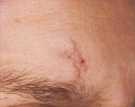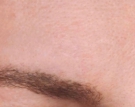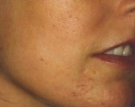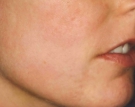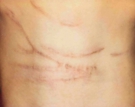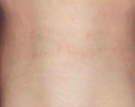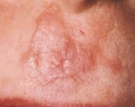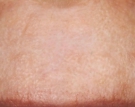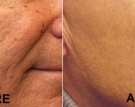Scars

Scar formation is inevitable when damage from an injury enters the deeper layers of the skin. The causes of scars are many and varied including external trauma such as abrasions, cuts, or burns and internal trauma from disease entities such as acne, chicken pox, and shingles.
Scar revision (sometimes called scar removal) requires an observant eye and a creative multi-dimensional approach to be successful. Component analysis of the scars is the first step. A scar may be linear, raised, thick, depressed, uneven, vascular, hyperpigmented (brown discoloration), or hypopigmented (devoid of color). By treating each of the components of the scar, the overall improvement is usually greatest. Cortisone injections, medicated creams, W-plasty, resurfacing lasers, vascular removal lasers, pigment removal lasers, percutaneous collagen induction, and micropigment implantation are techniques that are used in isolation or in combination to improve the appearance of a scar. Multiple treatment sessions are usually required to achieve the best results.
In most cases the ideal time to begin scar revision is 6 to 12 weeks after the wound has occurred. This allows the laser surgeon to direct the body’s natural healing process to an improved cosmetic result. In certain cases, re-excision of old scars is performed prior to laser treatments in order to re-establish the 6 to 12 week window of opportunity for laser scar revision.
Before and After Scar Photos
**Actual patients. Individual results may vary.
Treatments
Frequently Asked Questions
What can be done to treat a raised scar?
What can be done to treat a linear scar?
What can be done to treat a thick irregular scar?
Regular use of medicated creams containing tretinoin and/or glycolic acid are often used in combination with laser resurfacing. These creams help to realign the collagen building blocks of the skin as well as smoothing out irregular texture which is common to most scarring.
What can be done to treat a Keloid scar?
What can be done to treat a depressed scar?
Saucer-shaped depressions in the skin require a different approach. To elevate the skin, dermal fillers are generally the treatment of choice.
Another option for the treatment of saucer-shaped depressions is to vaporize the elevations around the depression with a CO2 resurfacing laser. This helps the depression to look less obvious.
What can be done to treat a scar with vascular discoloration?
These lasers are effective because the wavelength of light that penetrates the skin has a selective affinity for blood vessels. It passes harmlessly through the top layer or epidermis of the skin leaving it essentially intact. When it hits the targeted blood vessels, the Vbeam Laser causes a microscopic fragmentation of the blood cells. The dispersed blood cells, in the form of a bruise, are then carried away by the body’s garbage collecting cells (macrophages) leaving behind normal skin. The Help G laser seals the blood vessels and does not leave a bruise after the treatment.
What can be done to treat a scar with changes in pigment?
The state of the art PicoWay laser works in a similar fashion to the dye laser. The intense light from the laser passes harmlessly through the top layer of the skin and is selectively absorbed by brown, black or blue pigment in the skin. The energy emitted by the laser light when it is absorbed causes the melanin or foreign material to break into miniscule particles that are removed by the body’s immune system.
Hypopigmentation or the lack of color in a scar can be very difficult to change. It may be improved by the meticulous injection of flesh colored pigment into the scar with a technique known as micro-implantation. The other option is simply to cover the scar with cosmetics such as Derma Color.
Who is responsible for the payment of Scar Revision Therapy?
In some cases a private insurance plan may pay for the treatment. This must be arranged by the patient.
Do you have another question that wasn’t addressed here? Please feel free to contact us with any questions or concerns you may have!

